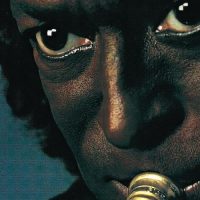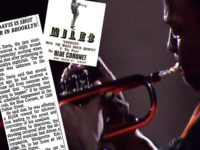As a lifelong Louisianan, I have great appreciation for the Feb. 12, 1964 performance by Miles Davis and his still-evolving Second Great Quintet at Philharmonic Hall in New York. The concert produced two albums that remain in very high regard, with ballads compiled into 1965’s My Funny Valentine and intense, high-velocity takes on 1966’s ‘Four’ and More.
The date of the concert is part of the historical significance – the birthday of President Abraham Lincoln. The event is often referred to as the Lincoln Day Concert, and it was performed in the newly opened Philharmonic Hall in Lincoln Center, now known as Avery Fisher Hall. The 24th Amendment to the United States Constitution outlawing poll taxes as a voting requirement was ratified only three weeks earlier. The following July, Freedom Summer activists would see President Lyndon B. Johnson sign the landmark Civil Rights Act, and the following year brought the Voting Rights Act.
The concert produced more than the two famed albums, however, as it was a fundraiser to benefit projects of the Voter Education Project in Louisiana and Mississippi. According to author Gerald Lyn Early, Steven Currier was a major financier of the Voter Education Project after the 1961 Freedom Rides. Currier insisted that the three beneficiary organizations, the Student Non-Violent Coordinating Committee (SNCC), the Congress of Racial Equality (CORE), and the National Association for the Advancement of Colored People (NAACP) Legal Fund share the proceeds from the Lincoln Day Concert – and each organization agreed, lacking alternatives.
Amid these rapid and controversial changes, the Lincoln Day Concert at Philharmonic Hall illustrates multiple aspects of the times, and of Miles Davis himself. Miles, as was his wont, “didn’t do exactly what everybody else did,” Early concludes. To attract high-dollar donors and audience members, Miles allowed his personal stationery to be used to advertise the benefit concert. The organizers felt this would receive greater attention than the letterhead of one of the civil rights organizations.
Early quotes the letter: “The civil rights movement is launching an all-out drive to register Negro citizens in Mississippi and Louisiana. Hundreds of field workers are pouring into these states at this moment, setting up registration clinics, preparing potential voters for registration tests, transporting citizens to the registrars’ offices. All of this costs money – and the most urgent need is for cars – durable automobiles that can transport our people into and out of the widespread rural areas of both states.”
At the start of the headlining performance, the Quintet members were introduced by popular jazz disc jockey Mort Fega: “I’d like you to know a young man who has created quite a stir in the music world, his name is Tony Williams. Tony Williams – when you see this young man, you know that there’s a lot of good music yet to be made. I think Tony’s about 19 years old; it’s kinda scary that a young man should have so much talent. On bass, a gentleman whom I’m sure you all know, Mr. Ron Carter. Ron Carter. And I think we’ll finish the rhythm section. Playing piano tonight, Herbie Hancock. And playing tenor saxophone – and this fella’s gonna scare you tonight if he hasn’t already, I’m sure, Mr. George Coleman. George Coleman. And I know you have a big ovation for the gentleman who fronts this group, Miles Davis …”
In reality, Fega’s light-hearted introductory remarks were in stark contrast to the mood rapidly developing backstage: The band members knew about the concert for weeks in advance of the event. However, Miles Davis did not inform them that their fees would be donated to the cause. They found out the news from the band leader right before they walked onto the Philharmonic Hall stage. The response was quick and vociferous.
At this time, Miles was earning approximately $200,000 per year while living in the five-story, 10-room former Russian Orthodox church on West 77th Street he bought in 1960. The band members usually earned in the neighborhood of $100 to $200 per gig with Miles, but at this early stage of the Quintet most of the musicians had not played in some time, which made the frustration more acute.
“Everyone else is like, no, we’re not doing it for free,” journalist Colin Fleming summarized in an interview with NPR. “They have a big row, they go on, and basically they play this kind of speed-metal, punk, thrash-jazz, with Davis acting almost as conductor.”
On this night, Miles Davis played hard ball, informing the complaining musicians that a future of performing with him was contingent on their agreeing to forego their earnings for the benefit. The result? “I think that anger created a fire, a tension that got into everybody’s playing,” Davis wrote in his autobiography, “and maybe that’s one of the reasons everybody played with such intensity.” As stated in the book We Want Miles, “Listening to ‘Stella by Starlight’ gives an idea of the extravagant liberties taken by the band.”
Ted Gioia, in The History of Jazz, comments on the duality of the Quintet under Miles’ direction: In the studio, the band was “a pioneering unit performing quasi-abstract original compositions, whose musical iconoclasm bordered on the avant-garde,” while on stage the set list was a continuation of ballads and originals that Miles had performed for years. The explanation is found in how those standards were played during this mid-1960s period: “In performance, the Davis band played the old songs with such experimental zeal that no one could have accused the band members of harboring the slightest tinge of nostalgia or conservatism. Davis’s live recordings from the mid-1960s are exhilarating documents.”
While Gioia is likely referring primarily to the Quintet whose membership was set for five years when Wayne Shorter replaced Coleman on saxophone in September 1964, the recordings of the Lincoln Day Concert show that the pattern was in place by much earlier in the year. Most commentary on the recordings agree that “My Funny Valentine” and “Stella by Starlight” exemplify the extended improvisational ballads, while the band “rampages” through “So What” and other uptempo selections.
In his book Miles Davis and American Culture, Early’s research revealed details of the concert’s impact: The three civil rights organizations would share the night’s earnings of $6,000. Miles would receive letters from CORE, stating that $1,000 of the $6,000 was being used for voter registration efforts in Iberville, LA, in Iberville Parish. Another $1,000 was going toward repair and rebuilding of the Plymouth Rock Baptist Church in the town of Plaquemine, also in Iberville Parish not far from Baton Rouge. The church had been damaged by tear gas and water during the events of August-October 1963, a time of social unrest in the small town.
The last moments before the concert would not be the only time Miles Davis employed what he called “creative tension” in his autobiography as a means of spurring his band members into intense and innovative sessions. On the evening of Feb. 12, 1964, the social context of that night’s concert added an extra layer of seriousness and significance to the performance.
The night was summed up in the introduction of the second set by pianist and educator Billy Taylor: “Thank you very much. You know, it’s a wonderful feeling to see so many people interested not only in the remarkable talents displayed, but people who are also interested in human rights. And what could be better, on Lincoln’s birthday, than the very sensitive music, the beautiful sound, of the Miles Davis Quintet?”




